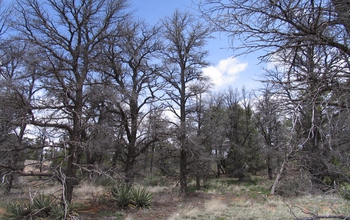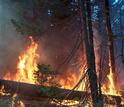Hola amigos: A VUELO DE UN QUINDE EL BLOG., hemos recibido información de la Fundación Nacional de Ciencias de Los Estados Unidos, nos dice: "Bosques en todo el país están sintiendo el calor de la creciente sequía y el cambio climático, según un nuevo estudio realizado por científicos de 14 instituciones de investigación.
"En las últimas dos décadas, las temperaturas más cálidas y precipitaciones variables han aumentado la severidad de las sequías forestales en gran parte del territorio continental de Estados Unidos", dijo James Clark, autor principal del estudio y científico ambiental en la Universidad de Duke.
Clark y sus colegas publicaron su trabajo en la revista Global Change Biology.
"Mientras que los efectos han sido más pronunciada en Occidente, nuestro análisis muestra virtualmente que todos los bosques de Estados Unidos están experimentando cambios y son vulnerables a futuras caídas", dijo Clark.
Es una tarea difícil predecir lo que estos bosques se verá como en 20 años, según los investigadores.
"En las últimas dos décadas, las temperaturas más cálidas y precipitaciones variables han aumentado la severidad de las sequías forestales en gran parte del territorio continental de Estados Unidos", dijo James Clark, autor principal del estudio y científico ambiental en la Universidad de Duke.
Clark y sus colegas publicaron su trabajo en la revista Global Change Biology.
"Mientras que los efectos han sido más pronunciada en Occidente, nuestro análisis muestra virtualmente que todos los bosques de Estados Unidos están experimentando cambios y son vulnerables a futuras caídas", dijo Clark.
Es una tarea difícil predecir lo que estos bosques se verá como en 20 años, según los investigadores.
More information....
 Credit and Larger Version |
Forests nationwide are feeling the heat from increasing drought and climate change, according to a new study by scientists from 14 research institutions.
"Over the last two decades, warming temperatures and variable precipitation have increased the severity of forest droughts across much of the continental United States," said James Clark, lead author of the study and an environmental scientist at Duke University.
Clark and colleagues published their paper today in the journal Global Change Biology.
"While the effects have been most pronounced in the West, our analysis shows virtually that all U.S. forests are now experiencing change and are vulnerable to future declines," Clark said.
It's a tall order to predict what these forests will look like in 20 years, the researchers say.
Drought across the U.S. West
Drought-induced forest diebacks (the deaths of entire communities of trees known as stands), bark beetle infestations, and wildfires are already occurring on large scales across the West. Many models predict droughts are likely to become more severe, frequent and prolonged across much of the U.S.
Evidence is also mounting that climate is changing faster than tree populations can respond.
As conditions become drier and warmer, many tree populations, especially those in Eastern forests, may not be able to expand into new, more favorable habitats, fast enough to keep up.
"Most forest research is carried out at local study sites, where trees are individually catalogued and measured," said Henry Gholz, a program director in the Division of Environmental Biology at the National Science Foundation (NSF), which supported the research. "This approach risks 'missing the forest for the trees.'"
The new results show that changes in both western and eastern U.S. forests could happen quickly under drier conditions in the future, said Gholz.
"Prolonged drought affects wildfire risks, species distribution, forest biodiversity and productivity, and virtually all goods and services provided by forests," Clark said, "so there is a pressing need to know what is happening now, what might happen in the future, and how we can manage for these changes."
Forests and drought, from A to Z
The new paper addresses this need by providing a comprehensive overview of current and projected drought effects on forests nationwide, how they vary by region, and which management practices could help to partially mitigate adverse effects.
The paper also identifies critical gaps in our knowledge base that hinder scientists' ability to predict the pace and extent of future drought effects on forests.
"We currently have a pretty good handle on predicting the impacts of climate change and drought on individual trees," Clark said. "Ecologists have identified many of the important differences between species that explain how they respond differently to drought."
But, he said, uncertainty still exists about what might happen at the species-wide or stand-wide levels, particularly in Eastern forests. "These are the scales where we really need reliable predictions so forest managers can take steps now to help reduce large-scale adverse future effects."
Without a stronger basis for understanding how the complex interactions among trees, species and environmental conditions work at broader scales, even the most sophisticated current models can provide only limited guidance, Clark said. "That's where we need to focus our efforts now."
Major co-authors of the paper are Louis Iverson and Christopher W. Woodall of the U.S. Forest Service, as well as scientists with the U.S. Geological Survey, the University of Vermont, the University of California (UC), Santa Barbara, Sarah Lawrence College, the University of Michigan, the University of Arizona, Ohio State University, Harvard Forest, UC Davis, Northern Arizona University and the Swiss Federal Research Institute.
-NSF-
Media Contacts Cheryl Dybas, NSF, (703) 292-7734, cdybas@nsf.gov
Tim Lucas, Duke University, (919) 613-8084, tdlucas@duke.edu
Related WebsitesNSF News: Cause of California drought linked to climate change: https://www.nsf.gov/news/news_summ.jsp?cntn_id=132709
NSF News: Drought, heat likely to affect U.S. West's power grid: http://www.nsf.gov/news/news_summ.jsp?cntn_id=135021
NSF Discovery: Earth Week: Bark beetles change Rocky Mountain stream flows, affect water quality:
http://nsf.gov/discoveries/disc_summ.jsp?cntn_id=130951
NSF Discovery: Ghosts of Forests Past: Bark Beetles Kill Lodgepole Pines, Affecting Entire Watersheds:
http://www.nsf.gov/discoveries/disc_summ.jsp?cntn_id=128398
NSF Discovery: Born during a drought: Bad news for baboons: http://nsf.gov/discoveries/disc_summ.jsp?cntn_id=134000&org=NSF
The National Science Foundation (NSF) is an independent federal agency that supports fundamental research and education across all fields of science and engineering. In fiscal year (FY) 2016, its budget is $7.5 billion. NSF funds reach all 50 states through grants to nearly 2,000 colleges, universities and other institutions. Each year, NSF receives more than 48,000 competitive proposals for funding and makes about 12,000 new funding awards. NSF also awards about $626 million in professional and service contracts yearly.
Useful NSF Web Sites:
NSF Home Page:
http://www.nsf.gov
NSF News:
http://www.nsf.gov/news/
For the News Media:
http://www.nsf.gov/news/newsroom.jsp
Science and Engineering Statistics:
http://www.nsf.gov/statistics/
Awards Searches: http://www.nsf.gov/awardsearch/

Wildfires, with flames fanned by drought, are happening on large scales across the U.S. West.
Credit and Larger Version

Dying ponderosa pines cover a hillslope during the third year of a warm drought in California.
Credit and Larger Version

Symptoms of drought are appearing across the country, such as "leaf scorch" on this linden tree.
Credit and Larger Version

Bark beetles have moved in and killed large swaths of forests in the wake of drought.
Credit and Larger Version

Many tree species may not be able to expand into more favorable habitats fast enough.
Credit and Larger Version
The National Science Foundation (NSF)
Guillermo Gonzalo Sánchez Achutegui
ayabaca@gmail.com
ayabaca@hotmail.com
ayabaca@yahoo.com
Inscríbete en el Foro del blog y participa : A Vuelo De Un Quinde - El Foro!

No hay comentarios:
Publicar un comentario